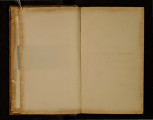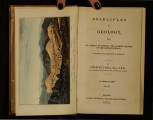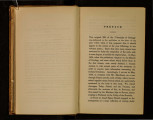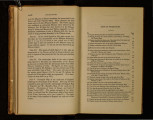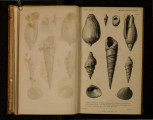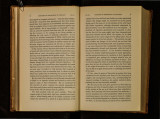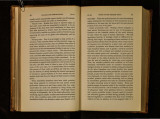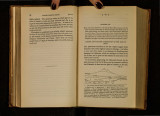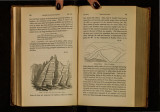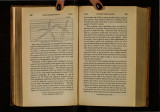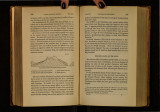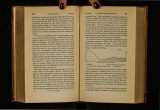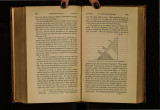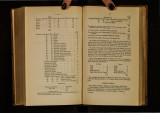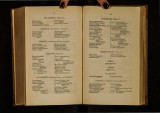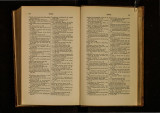| OCR Text |
Show 88 NJ~WER PLIOCENE PERIOD· [Ch. VII. will be seen dipping enter into the structure of the great cone, at a much more rapid angle. d tl sides of The lavas and tuffs, which have conforme to le . . f f· fift en to twenty-five degrees, wh1le Etua d1p at angles o 1om e fif d the sio e of the lateral cones is from thirty-five to . ty egre~s. Now wPh erever we mee t 'th sections of these buned cones m Wl ' . . b d · the Val del Dove, (and they are fre-the precipices or ermg . d · 1 . 1 . .a.·~ 11 d the Serre del Solfizw, an m t 1ose quent m the c JH;:, ca e l f ) near the 11 ea d of th e val ley not far from the .r oc<.. o .M usa.r a, we find t 11 e b e d s dI. ppm· 0a - at high angles and mclmed m vanous directions*. . Scenery of the JTal del Bove.-~ithout e~t:rmg at present into any further discussions res~ectmg the ~ngm of the Val del :Hove, we shall proceed to descnbe some .of Its most remarkab~e features. Let the reader picture to himself a large am~lutheatre five miles in diameter, and surrounded on three s1des b y prec'·i pi·c e s from two thousand to t•h. ree thousand fe.e t in hei ht. If he has beheld that most picturesque scene m the chagin of the Pyrenees, the celebrate d'c'1 rq ue o fG avarm.e,, he may form some conception of the mag~ificent circle of pr~cipitous rocks which inclose, on three sides, the great plum of the Val del Dove. This plain has been deluged by repeated streams of lava, and although it appears almost level when viewed from a distance, it is, in fact, more uneven than the surface of the most tempestuous sea. Besides the minor irregularities of the lava, the valley is in one part interrupted by a ridge of rocks, two of which, Musara and Capra, are very prominent. It can hardly be said that they -- ' like giants stand To sentinel enchanted laud;' for although, like the Trosachs, they are of gigantic dimcn· * I percl'ive that Professor Hoffmann, who visited the Val d~l Bove after me (in January, 1831 ), has speculated on its structure as correspondmg to that of the so-called elevation craters, which hypothesis would require that there should be a quaqua-vcrsal dip, such as I have above alluded to. I can only account for this difference of 011inion, by supposing the Professor to l1ave overlooked the 11heno· mena of the buried cones.-Archiv filr Mineralogic, &c. Berlin, 1831. Ch. VII.] SCENERY OF TilE VAL DEL BOVE. 89 sions, and appear almost isolated as seen from many points, yet the stern and severe grandeur of the scenery which they adorn is not such as would be selected by a poet for a vale of enchant· ment. The character of the scene would accord far better with Milton's picture of the infernal world ; and if we imagine ourselves to behold in motion, in the darkness of the night, one of those fiery currents, which have so often traversed the great valley, we rna y well recall -- ' yon dreary plain, forlorn anu wild, The seat of desolation, void of light Save what the glimmering of these vivid flames Cast pale and dreadful.' The face of the precipices already mentioned is broken in the most picturesque manner by the vertical walls of lava which traverse them. These masses usually stand out in relief, are exceedingly diversi6ed in form, and often of immense altitude. In the autumn, their black outline may often be seen relieved by clouds of fleecy vapour which settle behind them, and do not disperse until midday, continuing to fill the valley while the sun is shining on every other part of Sicily, and on the higher regions of Etna. As soon as the vapours begin to rise, the changes of scene arc varied in the highest degree, different rocks being unveiled and hidden by turns, and the summit of Etna often breaking through the clouds for a moment with its dazzling snows, and being then as suddenly withdmwn from the view. An unusual silence prevails, for there are no torrents dash· ing from the rocks, nor any movement of running water in this valley, such as may almost invadably be l1eard in moun. tainous regions. Every drop of water that falls from the heavens, or flows from the melting ice and snow, is instantly absorbed by the porous lava; and such is the dearth of springs, that the herdsman is compelled to supply his flocks, during the lwt season, from stores of snow laid up in hollows of the mountain during winter. The strips of green herbage and forest-land, which have |




